NO MORE Wasting Those Greens!
I know I’ve mentioned it before, but I can’t get over how expensive food is becoming! It’s scary, especially since nutritious, whole foods are our first line of defense in guarding our health. In that light, economizing by cutting back on healthy food is no answer. So how do we continue to eat well and afford it too?
One obvious answer is to control food waste. And a good place to start is with the refrigerator vegetable/crisper drawer—managing it better, that is. We waste a lot of money over a year’s time by neglecting our greens. If they’re not prepped properly, or stored properly, or used up quickly enough, they go bad (aka ROT) and we end up throwing them out. (Is anyone relating to this scenario?)
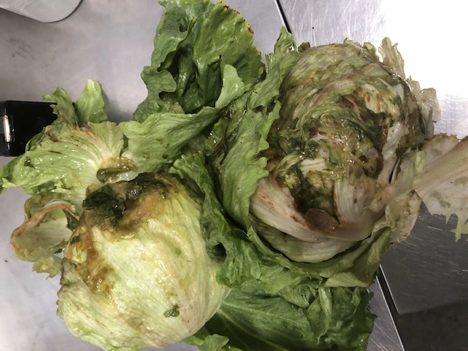
Also, this wasted greens pattern tends to make it seem wiser and easier to opt for bags or boxes of pre-cut salad greens rather than bunches of lettuces. It may be easier, but it’s definitely more expensive to go that route. After all, we’re paying for someone to sort, wash, dry, and bag the stuff—as well as paying for the packaging.
So, let’s consider skipping pricey salad packs and wash and spin-dry lettuces ourselves. The clean greens can be stored in a paper towel-lined salad spinner for up to five days. They'll be ready to go when you want them (think main course salads) and much less likely to spoil. And in the process, we’re continuing to include nutrient-dense food in our meals!
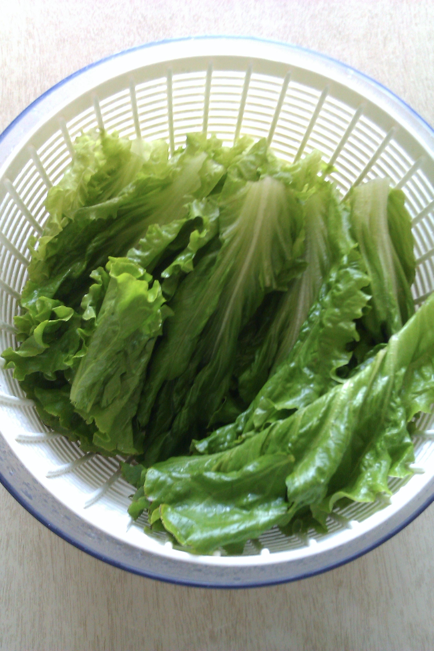
And speaking of nutrient-dense foods, here are some good things to know about leafy greens:
Lettuce, spinach and other salad greens are a year-round source of vitamin A, vitamin C, and beta-carotene, calcium, folate, fiber, and phyto-nutrients (anti-oxidants that help prevent cancers and heart disease). They lack cholesterol, are naturally low in calories and sodium, and are low in calories (only 7 per cupful). They’re considered a high-volume food—they fill us up because their satiety level is so intense.
Red and dark green leafy vegetables are generally higher in nutrients than light-colored greens (think iceberg lettuce as a light-colored green). In fact, research shows red leaf lettuce is considered the king of lettuces and has the most anti-oxidant compounds of all the lettuces available.
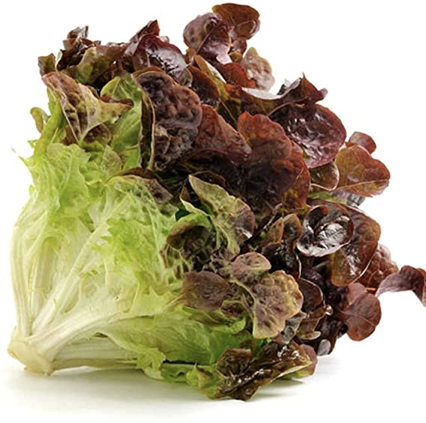
When it comes to prepping properly, here’s what the experts advise:
• Always wash hands before preparing salads and make sure you are working with a clean cutting board.
• Wash lettuce just before using by running cold water over leaves. Leaves can be difficult to clean so immersing the leaves in a bowl of ice water for a few minutes helps loosen sand and dirt.
Presoak lettuce and other greens for 10 minutes. After washing, blot dry with paper towels or use a salad spinner to remove excess moisture.
But what about those commercial fruit and vegetable rinses/washes? These chemical rinses and water treatments for washing raw produce are often advertised as the best way to keep fresh fruits and vegetables safe in the home. Are they effective though?
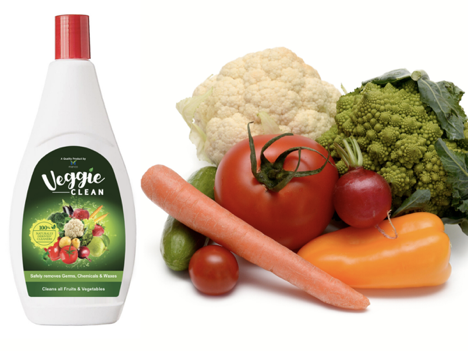
Researchers from the Department of Food Science and Human Nutrition at the University of Maine tested a couple commercial wash treatments and here’s what they found:
Fit® (Proctor & Gamble, Cincinnati, OH) washes got rid of roughly the same amount of microbes as distilled water. Both Fit® and distilled water reduced the level of residual pesticides compared to the unwashed samples.
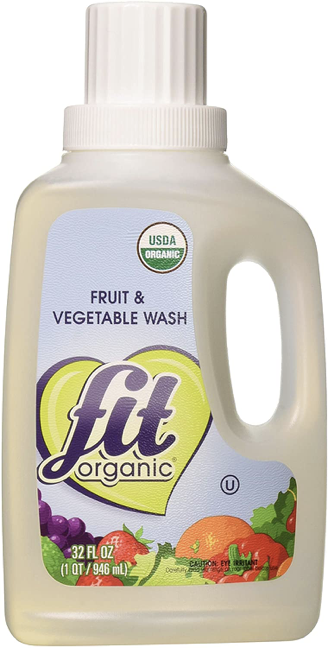
Ozone Water Purifier XT-301 (Air-Zone Inc., Leesburg, VA) removed microbes. However, the distilled water wash was more effective than either of the ozone washes.
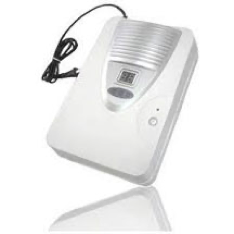
Because of their findings, and the fact that this equipment and washes are costly, the University researchers advise we simply wash fresh fruits and vegetables with distilled water. They say soaking all produce for one to two minutes will be effective.
Why use distilled water? Distilled or bottled water has been filtered and purified to remove contaminants. The University researchers do concede, however, that you can also used very clean cold tap water to clean produce instead of distilled water. OK—good to know, and validating as well. I’m stickin’ with plain, cold tap water.
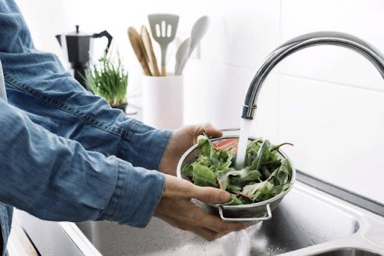
And while you can store your cleaned greens in your salad spinner as mentioned above, my favorite storage technique uses the green produce bags found in most produce departments now. I soak my greens, drain them well, and soak them again. After these two soakings, I spin them as dry as I can in the salad spinner, then I layer them between paper towels in one of these large green plastic produce bags.
The claims the ads make about these bags are really legit. They are worth every penny, and they can be reused several times before they lose their preservative powers.
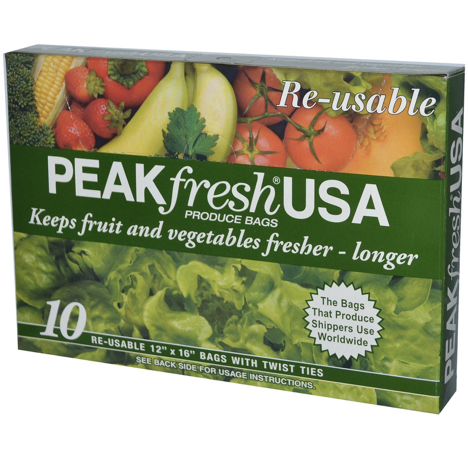
So now that we know we should keep buying greens (expensive or not), and we know how to clean and store them, HOW do we use them up quickly enough? I always include a handful in my morning green drink, and then “a salad-a-day” is my motto. Also, they are just delicious chopped up and included in veggie wraps. And some people skip the tortilla entirely and just wrap their wrap in lettuce.
The point is though, to remember that they’re snuggled into the vegetable/crisper drawer and be diligent in using them. This is not just the way to stop wasting those greens, it’s the way to continue to eat well and afford it too!
blog comments powered by Disqus
One obvious answer is to control food waste. And a good place to start is with the refrigerator vegetable/crisper drawer—managing it better, that is. We waste a lot of money over a year’s time by neglecting our greens. If they’re not prepped properly, or stored properly, or used up quickly enough, they go bad (aka ROT) and we end up throwing them out. (Is anyone relating to this scenario?)

Also, this wasted greens pattern tends to make it seem wiser and easier to opt for bags or boxes of pre-cut salad greens rather than bunches of lettuces. It may be easier, but it’s definitely more expensive to go that route. After all, we’re paying for someone to sort, wash, dry, and bag the stuff—as well as paying for the packaging.
So, let’s consider skipping pricey salad packs and wash and spin-dry lettuces ourselves. The clean greens can be stored in a paper towel-lined salad spinner for up to five days. They'll be ready to go when you want them (think main course salads) and much less likely to spoil. And in the process, we’re continuing to include nutrient-dense food in our meals!

And speaking of nutrient-dense foods, here are some good things to know about leafy greens:
Lettuce, spinach and other salad greens are a year-round source of vitamin A, vitamin C, and beta-carotene, calcium, folate, fiber, and phyto-nutrients (anti-oxidants that help prevent cancers and heart disease). They lack cholesterol, are naturally low in calories and sodium, and are low in calories (only 7 per cupful). They’re considered a high-volume food—they fill us up because their satiety level is so intense.
Red and dark green leafy vegetables are generally higher in nutrients than light-colored greens (think iceberg lettuce as a light-colored green). In fact, research shows red leaf lettuce is considered the king of lettuces and has the most anti-oxidant compounds of all the lettuces available.

When it comes to prepping properly, here’s what the experts advise:
• Always wash hands before preparing salads and make sure you are working with a clean cutting board.
• Wash lettuce just before using by running cold water over leaves. Leaves can be difficult to clean so immersing the leaves in a bowl of ice water for a few minutes helps loosen sand and dirt.
Presoak lettuce and other greens for 10 minutes. After washing, blot dry with paper towels or use a salad spinner to remove excess moisture.
But what about those commercial fruit and vegetable rinses/washes? These chemical rinses and water treatments for washing raw produce are often advertised as the best way to keep fresh fruits and vegetables safe in the home. Are they effective though?

Researchers from the Department of Food Science and Human Nutrition at the University of Maine tested a couple commercial wash treatments and here’s what they found:
Fit® (Proctor & Gamble, Cincinnati, OH) washes got rid of roughly the same amount of microbes as distilled water. Both Fit® and distilled water reduced the level of residual pesticides compared to the unwashed samples.

Ozone Water Purifier XT-301 (Air-Zone Inc., Leesburg, VA) removed microbes. However, the distilled water wash was more effective than either of the ozone washes.

Because of their findings, and the fact that this equipment and washes are costly, the University researchers advise we simply wash fresh fruits and vegetables with distilled water. They say soaking all produce for one to two minutes will be effective.
Why use distilled water? Distilled or bottled water has been filtered and purified to remove contaminants. The University researchers do concede, however, that you can also used very clean cold tap water to clean produce instead of distilled water. OK—good to know, and validating as well. I’m stickin’ with plain, cold tap water.

And while you can store your cleaned greens in your salad spinner as mentioned above, my favorite storage technique uses the green produce bags found in most produce departments now. I soak my greens, drain them well, and soak them again. After these two soakings, I spin them as dry as I can in the salad spinner, then I layer them between paper towels in one of these large green plastic produce bags.
The claims the ads make about these bags are really legit. They are worth every penny, and they can be reused several times before they lose their preservative powers.

So now that we know we should keep buying greens (expensive or not), and we know how to clean and store them, HOW do we use them up quickly enough? I always include a handful in my morning green drink, and then “a salad-a-day” is my motto. Also, they are just delicious chopped up and included in veggie wraps. And some people skip the tortilla entirely and just wrap their wrap in lettuce.
The point is though, to remember that they’re snuggled into the vegetable/crisper drawer and be diligent in using them. This is not just the way to stop wasting those greens, it’s the way to continue to eat well and afford it too!
Sources:
- www.martinsproduce.com
- www.eartheim.com
- www.amazon.com
- www.businessinsider.com
- www.thephoto-news.com
- www.iherb.com
 Alice Osborne
Alice Osborne
Weekly Newsletter Contributor since 2006
Email the author! alice@dvo.com
